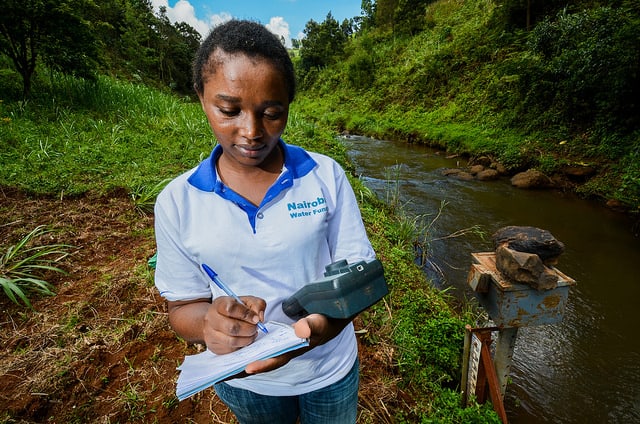Smallholder. Big data
Big data can help smallholders can become agriculture’s big players.

Photo by Georgina Smith
The typical image of big data is of big corporations shamelessly ‘stealing’ private data to generate enormous profits for faceless shareholders and enriching overpaid CEOs.
This popular stereotype, especially in the wake of the Cambridge Analytics scandal is not necessarily true, particularly in agriculture.
The advent of large amounts of freely available open agriculture data, as well as the plunge in the price of sensors, the ubiquitous internet-enabled mobile phone and the new network technologies such as LORA and LPWA, has brought big data into the realm of the small farmer.
Small and cheap sensors can be embedded into the soil to measure a variety of indicators such as soil PH, and small weather stations can be positioned to sample farm micro-climates.
These sensors can generate large amounts of data that can be used to predict the best harvesting window, herbicides application window and sowing window.
This hyper-local big data can be used in conjunction with open macro data in a machine learning strategy known as multi-view learning that can be used to improve predictions for many agricultural problems.
Both sources of data are within the grasp of smallholders.
Machine learning techniques once in the preserve of academics buried in universities are now available cheaply as a service from various vendors on the Internet. No PhD required.
The access to big data, both local and macro and their predictive properties can, not only level the playing field between smallholder and behemoth agricultural multi-national but, be the difference between survival and profitability.
This balance that the smallholder runs is no better demonstrated in Brazil where the majority of farmers are smallholders, who are at the whim of the weather.
The floods of 2011 in Rio de Janeiro, and the effects of the recent drought in the North-East and South-East of Brazil, demonstrate the power of nature in tropical South America.
Although smallholders probably would not be able to defend themselves against such freak occurrences, they can take remedial action against smaller, but no less dramatic, fluctuations in climate.
There are a number of start-ups in Brazil beginning to install hyper-local weather sensors in smallholdings and using that information in conjunction with other sources such as ClimaTempo or Open Weather Map to make more accurate predictions for specific locations of small farms.
Although this may seem a trivial application, even slight increases in the accuracy of weather predictions will allow smallholders to take remedial action to limit or mitigate the effects of climate fluctuations.
The further ahead of time that a smallholder can take action the less money and time the farmer will have to invest.
The aforementioned start-up companies provide the specific weather forecasts do so through intuitive and simple to interpret dashboards delivered to the ubiquitous mobile phone, or through alerts sent by email or SMS.
This fusion of ‘big’ hyper-local data and open macro data is not limited to weather forecasts.
There are a number of North American start-ups that are using macro satellite imagery and hyper-local imagery captured by drone to identify early signs of crop diseases or variance in crop quality.
Although private satellite imagery is available, there are a number of sources that offer satellite imagery for free.
Again, this allows small farmers to take remedial action to eliminate or mitigate the effects of disease. Early warnings allow for the limited use of herbicide or pesticide. This will save money and produce better results.
There is no doubt that the advent of cheap IOT devices will allow smallholders to gain benefits of the big data revolution. However, as with most revolutions, there are doubts that may inhibit the take up of big data analysis.
The big question is: who owns the data?
Where the service is free or cheap then the smallholder will become the product, and the data can be resold to other market players.
The aggregation of yield estimates for each smallholder can be resold to banks who are likely to be able to get a better estimate of the next harvest than through traditional means.
This can mean large profits on the community exchanges for the ultimate end user of the data. It is vital that smallholders have control of their data, and share in the profits of its exploitation.
The current Facebook scandal has given momentum to tighter data controls in many legal jurisdictions. But these controls must be built into the numerous start ups’ business models. Failure to do so will inevitably create a scandal equal to that of Facebook, and the smallholders’ trust will be lost forever.
Companies should see their potential customers as partners, and all uses of data must be transparent. And not hidden away in legalese.
Despite the potential for abuse, it is hoped that this brief defense of big data makes the case that it is not only for the big players, but also for the smallholder.
One of the latest and most important recent advances in the agriculture is precision agriculture, however, its adoption is directly linked with farmers with large acreage, who have benefited from mechanization, as well as the systematization of the use of their large capital equipment.
These approaches cost hundreds of thousands of dollars which puts precision agriculture beyond the reach of the smallholder.
The next frontier of agriculture is digital agriculture which will be available to all.
Open or freely available macro data can complement cheaply generated hyper-local that will allow the smallholder not only to survive but to compete on equal terms with the agriculture’s big players.
Brett Drury
Brett Drury is Head of Research at AgTech startup SciCrop where he uses probabilistic reasoning to enable small farmers to make better decisions
São Paulo, Brazil
Blog Competition Entry
This article is published as a part of our publicly open big data blog competition. If you have enjoyed this reading this entry, you can vote by liking, commenting or sharing.




